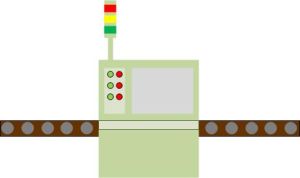Andon
Andon
Primary topic
Related topics
Methods and techniques
Andon is a visual system that notifies managers and workers of a problem with production process. It can be in form of large board with light signals or, more recently, large LCD screen showing information about quality problems. The andon system is linked with equipment that is able to detect problems or even stop the production. The famous equipment is Toyota andon cord. Every worker could pull the cord and stop the production. Nowadays, it is more common to use buttons.
Also the machines can have automatic detectors. That solution is called Jidoka and was developed by Toyota in early XX century as one of the first elements of Toyota production system.
Andon is one of Lean manufacturing pillars, together with: Konnyaku stone, Poka yoke, Hansei, Jidoka, Just in time, Heijunka, Kaizen, Genchi genbutsu, Nemawashi.
Andon system
In case of any problem related to process, following procedures apply.
Case 1. Worker detects problem
Example of andon system
- Worker detects problem. It can e.g.: lack of part, wrong colour of the part, defected element.
- Worker uses andon cord or button to signal the problem.
- The production is automatically stopped.
- The team of workers and managers meet and decide what to do with the problem. They have only limited time to solve it.
- When the time passed, the production has to be started again.
Case 2. Machine detects problem
- Machine detectors find quality problem
- The machine automatically stops and sends signal to andon board or turns on signal light
- The worker tries to solve the problem
- If the worker fails, he calls the team to solve the problem.
The method is not intended to solve sophisticated problems. It's purpose is to make high quality production possible again. Any more complex problems have to be solved separately.
Andon board

Fig. 1. Example of andon light installed on machine
Originally signal lights were installed on the machines. However when the production lines were implemented, it was not convenient. Therefore the andon cord idea was developed. But the signal should be passed somehow to all interested people. The large board with signal lights was usually installed in a place visible for everyone on the production floor. When the computer and intranet era came, those board were replaced by information systems. Now every interested employee and manager can see immediate alert on his computer or smartphone.
References
- Kemmer S.L., Saraiva M.A., Heineck L.F.M (2006) The use of andon in high rise building, Implementation and Performance Measurement, Proceedings
- da Silva, A.M. (2000) The Andon system: designing a CSCW environment in a lean organization, Inst. of Comput. & Nied.
- Tang C.S., Chan C.Y., Yung K.L (2006) The Development of a Generic Technique for Flow Line Monitoring, Engineering Letters, 14:1
Author: Slawomir Wawak
